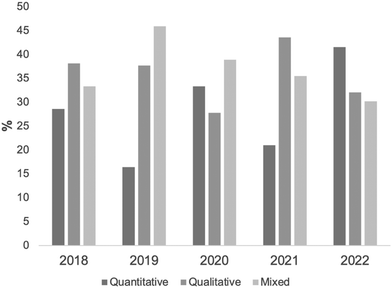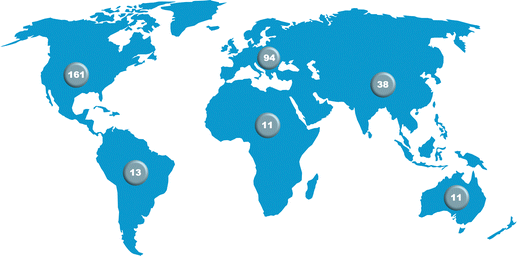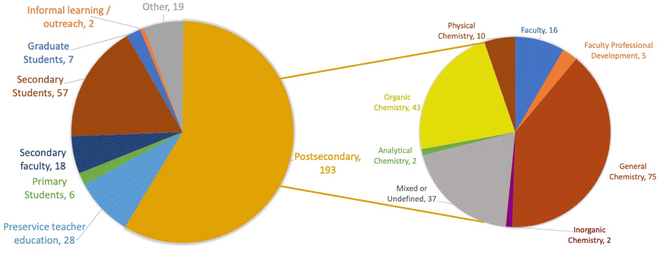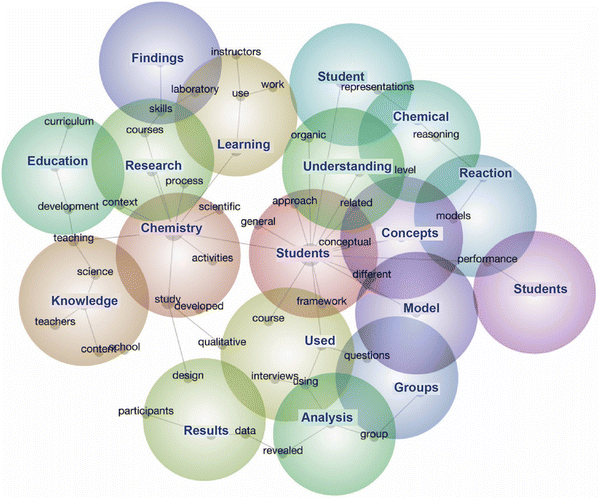Laying the foundations to build on: exploring diversity in our Chemistry Education Research & Practice community
Nicole
Graulich
 a,
Ajda
Kahveci
a,
Ajda
Kahveci
 b,
Gwendolyn A.
Lawrie
b,
Gwendolyn A.
Lawrie
 *c,
Scott E.
Lewis
*c,
Scott E.
Lewis
 d and
James
Nyachwaya
d and
James
Nyachwaya
 e
e
aInstitute of Chemistry Education, Justus-Liebig-University Giessen, Giessen, Germany
bDepartment of Chemistry, Fort Hays State University, USA
cSchool of Chemistry & Molecular Biosciences, The University of Queensland, St Lucia 4072, Australia
dDepartment of Chemistry, University of South Florida, USA. E-mail: slewis@usf.edu
eDepartment of Chemistry and Biochemistry and School of Education, North Dakota State University, USA
•Understand our research community
•Reflect the diversity of our community
•Share success to achieve impact
•Set minimum standards on which to build
Through this Editorial, we are taking time to reflect on the diversity in the work that has been shared in our journal during the past five years. Diversity literally means ‘variety’ or ‘containing many different elements’. Our intent is not to ignore the intrinsically linked dimensions of equity and inclusion; we recognise that our process of reflection helps to emphasize the gaps that can benefit from further attention. Indeed, post hoc analysis in terms of what has already been published, applying the lenses of equity and inclusion, is not viable since most authors have not reported representation amongst participants. We can, however, invite our community to share work that does involve these foci enabling researchers and practitioners to address the needs of all chemistry learners and access to learning.
During the past five years, our CERP community has experienced a transition from ‘normal’ teaching and research environments, through emergency response teaching within online environments, and into a new paradigm which is still complex and constantly evolving. Researchers and practitioners have found ways to adapt and continue to complete valued studies that inform the chemistry education community, therefore it seemed timely for us to consider diversity across the 344 articles that we have published in CERP between 2018 and 2022 (excluding Editorials, Reviews, Perspectives and Corrections). In doing so, we have an opportunity to highlight several areas that researchers can build on and explore further.
To enable a quick landscape view of research published in CERP during the past five years, an analysis of the combined abstract texts generates the concept map shown in Fig. 1. This map has been created through Leximancer software, a useful semantic analysis tool, revealing connections between themes and concepts from the texts (many qualitative researchers combine this tool with NVivo software to help research themes emerge inductively). Each theme (shown as a central node within each bubble) has connectivity to several concepts and these illustrate the strong focus within CERP on ‘students’ learning in terms of ‘understanding’ and ‘concepts’ leading to themes of ‘models’ and ‘chemical reasoning’ (linked to ‘representations’). Other theme clusters are observed which relate to the processes and contexts of chemistry education research. The themes and semantic concepts that have emerged in the map reflect the number of times they are linked in the text.
We can observe that our community has a common goal in improving student learning in chemistry, but a deeper exploration of the diversity in research and practice that has contributed to our journal's publications is required. The editorial team have collaborated to analyse articles published between 2018 and 2022 to establish the variability in learning contexts, methods, and geographical locations that are represented during this time period.
Methodological representation in chemistry education research
In chemistry education research, many different methodological approaches exist for collecting data based on the nature of the research questions and the study's context. Methodologies are routinely grouped into three categories: quantitative, qualitative and mixed methodologies. We have analysed and categorised reported methods into these broad categories, and each has a strong representation. This distribution mirrors our journal's mission to publish diverse research and evaluative methodologies (Fig. 2). It would not be appropriate to make any further inference based on any annual comparison of reported methodological studies because of the unquantifiable impact of COVID-19 on chemistry education research during 2020 and 2021. However, in 2022, we did observe a shift towards quantitative studies relative to other methods. | ||
| Fig. 2 Distribution of methodological approach categories in studies published between 2018 and 2022. | ||
As would be expected, quantitative methods were employed primarily in studies exploring the impact of an intervention, factors, affective measures or relationships between variables. Qualitative methods were mostly employed in studies seeking to make meaning or sense of participants’ experiences. The complementary nature of combining qualitative and quantitative approaches has been evident in studies applying mixed methods.
Around the globe – geographical diversity
We are taking the first steps towards achieving a minimum standard for inclusion and diversity as part of the RSC Framework for Action (2020). To inform actions that can increase the diversity of authors and study contexts published in CERP, we have evaluated the various countries of origin represented in the publications in the most recent five-year period. All six continents are represented in Fig. 3 (i.e. Asia, Africa, Europe, North America, South America, and Oceania). North America (including the USA and Canada) had the highest number of publications represented in studies in CERP, followed by Europe (20 countries). In Europe, the highest representation was from Turkey (30), recognising their very active chemistry education community. Germany (16) and UK (9) represented the second and third-highest numbers of study contexts in Europe. Asia was represented by seven countries and territories including China (14), Israel (8), Singapore (5) and Taiwan.† In South America, the four countries represented were Argentina (1), Brazil (5), Chile (6) and Uruguay (1). In Africa, the highest number of studies were situated in South Africa (8) with studies in Nigeria and Ethiopia also reported. Oceania was represented by a single country (Australia). Further, nine multinational studies were published reporting collaboration across international contexts in both Europe and North America. | ||
| Fig. 3 Geographical distribution of study contexts across six continents that have been represented in CERP articles (2018–2022). | ||
We regard it as very important to broaden our CERP community perspectives on chemistry education research and practice around the globe. Insights into chemistry curricula and concepts taught across global contexts when linked to student learning outcomes enable stronger evidence-based practice.
 | ||
| Fig. 4 Diversity in study contexts and participants published between 2018 and 2022 with the postsecondary context expanded to reveal sub-disciplinary information. | ||
The stronger focus on general and organic chemistry education in the past five years supports the claim that research in upper division and graduate courses has been minimal since the beginning of the 21st century (National Research Council, 2012). There also appears to be a gap in studies that have specifically examined intermediate and upper-level inorganic chemistry, analytical chemistry, and biochemistry learning contexts (combining to represent around 3% of postsecondary research). We should acknowledge at this point that many authors may use different language or terminology to describe their study's context, for example, ‘general’ chemistry is often referred to as ‘first-year chemistry’ in countries outside the US (this variability has been taken into account as part of the analysis). The postsecondary studies categorised as “mixed or undefined” were primarily those that were conducted with more than one type of participant population (e.g., students and faculty members), or with students in different course contexts, or where the research context was defined either briefly or in terms specific to the local settings.
Secondary chemistry education (17%) represents the second largest proportion of contexts overall; again terminology becomes important, in several articles this context is referred to as high school chemistry. Most of these studies have been conducted across different international contexts with the common goal of improving the teaching of specific chemistry topics via innovative strategies and methods. While only a small number of studies have been conducted with students at the level of primary education (about 2%), these contribute to the diversity of our journal. Studies conducted in preservice chemistry teacher education (8%) are well represented as the third highest group. Research on post-secondary faculty professional development appears to be scarce.
Examples of studies that have been classified as ‘Other’ include curriculum or textbook analyses, and studies reporting research on chemistry/career perceptions. Only two studies were conducted in informal learning and outreach contexts; therefore we recognise that this is a study context that could benefit from greater attention. However, a challenge for researchers is the process of capturing and evaluating chemistry learning in these latter contexts.
Exploring diversity as first steps to addressing equity and inclusion
Exploring diversity in representation amongst authors, teachers, students and learning contexts is critical for our journal to increase our focus on equity and inclusion in chemistry education. It was not possible to include gender diversity, racial diversity or ethnicity as part of our analysis since this data has not been collected by our journal. These represent very important aspects of diversity as part of our community. Through our analysis, we have recognised methodological, international and contextual diversity but we also regard it as important to identify the number of published articles in CERP that have considered issues around inclusion, access to learning, and student achievement. Across the period 2018–2022, these include studies that have focused on:• Diversity in prior learning or preparation (mathematics competence or aptitude); difficulties in learning (low achievement or at-risk); and consideration of gifted students’ learning.
• Cultural diversity including under-represented minority, first-generation and linguistically diverse students
• Gender bias
In identifying perceived and real barriers to student learning and success, many authors make recommendations for practitioners regarding inclusion of different equity groupings of learners. Another emerging strategy is to increase diversity in learning environments, teaching resources, and assessment practices. The application of Universal Design for Learning (UDL) guidelines (CAST, 2018) offers a holistic approach to instructional design that provides all learners with the flexibility to engage and be supported in learning environments. In a post-COVID landscape, the focus on student belonging as part of a learning community has increased, whether that relates to a specific classroom, an institution or to post-secondary education.
In conclusion, this analysis sheds light on CERP's reflection of the diversity in the global chemistry education community, which is encouraging and can be considered a solid foundation to build on. We look forward to identifying actions that we can take as an editorial team to increase diversity in authors and research studies that are published in CERP, particularly in terms of the focus on equity and inclusion for all learners. We are committed to applying the steps recommended as part of the RSC Framework for Action (2020) to attempt to minimise bias in publishing.
References
- CAST, (2018), Universal Design for Learning guidelines (Version 2.2), National Center on Universal Design for Learning. Last accessed December 13th, 2022, http://udlguidelines.cast.org.
- National Research Council (NRC), (2012), Discipline-Based Education Research: Understanding and improving learning in undergraduate science and engineering, Washington, DC: The National Academies Press DOI:10.17226/13362.
- RSC Joint Commitment, (2020), Joint commitment for action on inclusion and diversity in publishing, Last accessed December 11th 2022. https://www.rsc.org/new-perspectives/talent/joint-commitment-for-action-inclusion-and-diversity-in-publishing/.
- RSC Framework for Action, (2020), A framework for action in scientific publishing, Last accessed December 11th, 2022, https://www.rsc.org/new-perspectives/talent/framework-for-action/.
Footnote |
| † The Royal Society of Chemistry remains neutral with regards to jurisdictional claims in our published material, including the naming of territories in maps and institutional affiliations. |
| This journal is © The Royal Society of Chemistry 2023 |

